Sarah Zama's Blog, page 52
May 16, 2017
The Mystery Blogger Award
Well, would you imagine it? C.D. Gallant King nominated me for the Mystery Blogger Award, and I’m so excited! It’s been such a long time since last I received a nomination from a fellow blogger, which is always such great reward. Receiving an award is always rewarding, but receiving it from a fellow blogger who appreciate the work you’re doing on your blog is doubly so, because it comes from someone who knows fully well what goes into maintaining a blog. At least, this is how I feel.
So thank you CD, you rock!!!
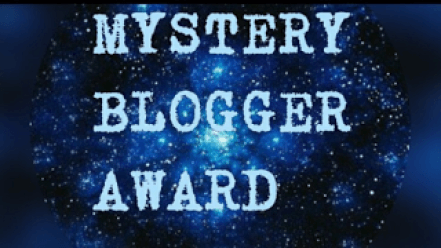
Created by Okoto Enigma’s Blog
Rules of the Mystery Blogger Award
Post the award on your page
List the rules
Thanks whoever nominated you for the award
Mention the creator of the award and provide a link as well
Tell readers three things about yourself
Nominate people
Notify your nominees
Ask your nominees 5 questions of your choice, with one weird of funny question
Share a link to your best post
Three things about myself
I have a cat named Apache, who’s my baby
I like baking. Normally, I manage to pull it off quite nicely. My most appreciated cake is the Rum Flavoured Chocolate and Pears Pie, which is my own recipes.
I like people-watching and eavesdropping on public transports, which are awesome places to get ideas for characters. Professional weakness, I suppose.
CD’s questions for me
What’s your favourite book and why?
At the moment (and I say this because this is a matter that of course changes over time), my favourite book is Reservation Blues by Sherman Alexie. It’s a multilayer kind of storytelling that mixes flawlessly fantasy and realism, in a way that adds to both genre rather than take out of them. That’s the kind of stories I want to write.
Who is your favourite professional wrestler?
I think I haven’t seen a wrestling match since the 1980s. I don’t think I’m qualified to answer this question.
Favourite type of character to play in roleplaying games? If you don’t play roleplaying games, how about video games? LARP? Cops & robbers? Monopoly? Do you do ANYTHING fun?
I used to roleplay in the late 1990s. It was a email-based kind of roleplaying game. Ton of fun, and honestly I learned a lot about storytelling and the flexibility stories requires to storytellers.
My character was a rogue, and what I loved about him is he was a shape-shifter too. He had a double nature of human and animal. I’ll confess I’ve always had a soft spot for shape-shifters.
You’re about to be dropped into a fictional universe and be granted really cool powers – quick, which one do you want to be: A Jedi (or Sith) in Star Wars, a witch or wizard in Harry Potter, or a mutant in X-Men?
Well, you’ll guess this. I want to be a mutant. Though about my powers… mhm… know what? I’d like to be some kind of batwoman, who moves silently but can hear perfectly (though I’d also like to see perfectly). Would turn extremely useful when people-watching and eavesdropping.
Favourite Canadian Prime Minister?
Canadian Prima Minister? What’s that? Something you’re supposed to eat?
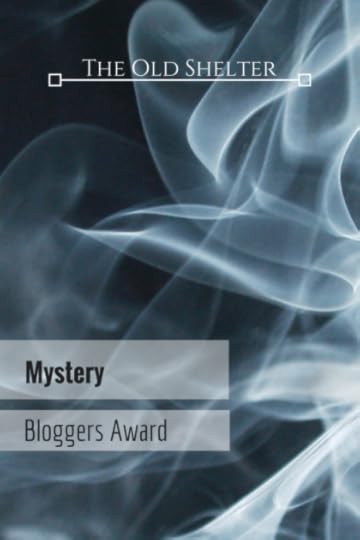
My 5 question to my nominees
People (especially readers) always dream about being in different place. What is a place (an actual place, a fantasy world or a different historical period) you’d rather live?
What do you like most about that place, why would you prefer it to the place where you actually live?
You’re aware no place is an absolute paradise, don’t you? What do you hate about that place you’ve chosen?
If you could build your own perfect world, what author would you ask to worldbuild it?
If you could be the hero of a story, what genre would that story be?
My Nominees
Since this story came from the AtoZ Challenge, I’d like to nominee three AtoZers
Barbara @ Life & Faith in Caneyhead
And finally, I should post a link to my best post. That’s hard pressing, eh?
Honestly, I feel I should post something about the New Woman’s New Look series, because you guys appreciated it so much. I’m going to share one post I’m particularly fond of, instead.
Blood – There are always voices calling and I’ll always listen
To be honest, I enjoyed a lot writing all four diaries of my characters, but I’m particularly fond of Blood’s post because I had such an hard time with him. Not because I had a hard time writing him – on the contrary, it has always been a pleasure – but because Blood is such a positive character that for a long time I feared readers would hate him. Because you know, readers are always fascinated with dark, brooding, tormented characters (that would be Michael, more like), and I feared that a good-hearted, positive, warming, eager to help character like Blood would be dismissed as too good and uninteresting.
Turned out it isn’t like that, and I’m so happy for him!
It was a pleasure, CD. Thanks again for thinking about me!
The post The Mystery Blogger Award appeared first on The Old Shelter.
May 13, 2017
Gang Roundup – May 2017
I promise I tried to post a Gang Roundup in April, but it simply didn’t happen. I kept telling to myself that ‘this week I’m finishing to schedule my posts, and I’ll prepare the roundup”, but that week ended up being the last in April. At that point I though it was just as well that I posted in May. And it’s also quite late too.
I know, I know, I’m a disaster at deadlines.
But the good news is that you get a two months worth of links, how about that?
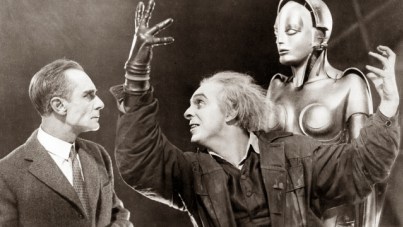 Metropolis at 90
Metropolis at 90Carrie-Anne over at Welcome to My Magick Theatre Blog always blogs about silent films on their birthday. That’s true. She’s seen more than 1000 silent films and I can assure you that she knows what she’s talking about.
I like her film-birthday posts a lot, becuase she always goes in great detail about the film history.
So it’s no surprise that, Metropolis being one of my favourite silent movies (and stories) I enjoyed her birthday posts a lot.
Here’s the whole series, but if you brows her blog, you’ll find other similar series for different films.
Part I | Part II | Part III | Part IV
About the Irish Wars
David Lawlor is the author of a series of (at the moment) four novels set during the Irish War of Indipendence and Civil War spanning from the Easter Rising (1916) to the mid 1920s.
He’s not only an expert of this time, but is also very passionate about it since his family – particularly his grandfather – was actively involved in these wars.
David writes fascinating articles about the Irish 1920s. Here are a couple of the most recent.
Ireland’s Civil War – when truth was stranger than fiction…
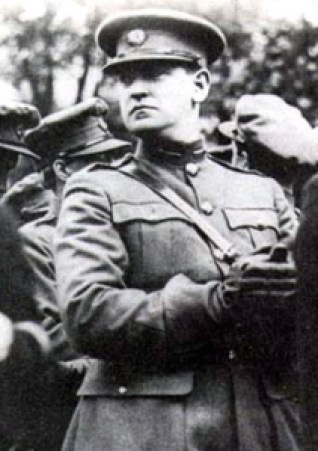
Michael Collins
Michael Collins is one of the most well-known and loved Irish patriots, though some say (and David is among them) that he remained an unblamished figure of hero because is died young. His death impacted Irish history in more than one way, and though it was in part caused by Collins’s own disregard for his safety, external events also had a great importance.
Among this, the rivarly between two brothers who chose the opposing sides of the fence in the Civil War.
How 1916’s rebels dressed to impress
It won’t come as a surprise that what I most like about history is its social aspect. I am interested in the big events, of course, but what really fascinates me is people’s everyday life. What they wore, what those things cost, where people bought them, and if at all possle why they bought them.
In this article, David has a closer look on how the rebels of the Easter Rising dressed, what it cost to them and even why they chose to dress like that.
Fascinating stuff, if you ask me.
The Irish Novel That’s So Good People Were Scared to Translate It
So, let’s stay in Ireland for a bit longer.
“Cré na Cille” (Churchyard Clay) is a novel that was written in Irish Gaelic in 1948. It is a satiric piece of literature recounting the observations of spirits in a graveyard about life around them – and especially their own fellow townfalk.
Translating a text is much more than just match wronds from a language into another. It’s more than finding the right sintax to render a sentece in a different language. It is also a work of interpreation, where not just the mining, but also what is beneath it has to be translated, and before that can be done, it has to be interpreted, which means interprete an entire way of life from a different perspective.
No wonder that for decades Irish translators refused to work on this novel for fear to mistranslate the text into English. And even more intersting that now there are two new translations, and they sounds quite different one from the other.

See the 1920s Come to Life in Gorgeous Color Videos
If you are like me, you’ll think that the first attempts at colour in the film industry were in the 1940s. Well, I should think again. Turns out the first attempts at colour were in the 1920s.
Have a loook!
Miss Fisher’s Murder Mysteries: The Feminist Sherlock You Should Be Watching
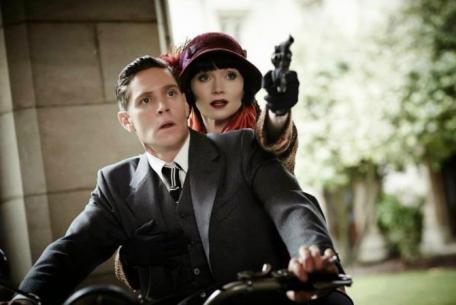 I know I’m coming to this series (both novels and tv show) very late, but I’m really enjoying it (you might have noticed). Miss Fisher Mysteries are among the best research 1920s stories I’ve encountered so far, and this is a great plus in addition to very relateble characters and intersting plots.
I know I’m coming to this series (both novels and tv show) very late, but I’m really enjoying it (you might have noticed). Miss Fisher Mysteries are among the best research 1920s stories I’ve encountered so far, and this is a great plus in addition to very relateble characters and intersting plots.
It is true that there are attitudes in the stories that are more modern, but I like the way Kerry Greenwood handles them, so that this is still acceptable in a historical setting.
This article looks in-death at what are the most stricking characteristics of this series (and this characters), how they relate to the historical setting and why they appeal to the modern readers.
The Early Women Filmmakers Blogathon is here!
I’m sorry that my messy March didn’t allow me to talk about this, but it’s still worth checking out. This is a blogathon organised by Movie Silently about women in the film industry in the 1910s and 1920s. Quite a few surspirses in here.
“Today, women direct under 10% of all films released and entertainment writers act as though women with megaphones are a modern phenomenon. Hold your horses! Alice Guy was not just one of the first women to direct, she was one of the first directors, period. Mabel Normand taught Charlie Chaplin a few tricks. Lois Weber was diving into social issues in film before Angelina Jolie’s grandmother was born. Women have always been directors, whether the men liked it or not.
It’s time to give these talented women directors their moment in the sun and the Early Women Filmmakers Blogathon aims to do just that. This is a topic that is dear to my heart and I am just tickled pink to be hosting!”
Renaissance by Yecheilyah Ysrayl
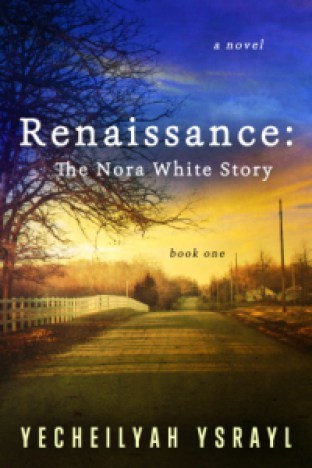 When seventeen-year-old Nora White successfully graduates High School in 1922 Mississippi and is College bound, everyone is overjoyed and excited. Everyone except Nora. She dreams of Harlem, Cotton Clubs, Fancy Dresses, and Langston Hughes. For years, she’s sat under Mr. Oak, the big oak tree on the plush green grass of her families five acres, and daydreamed of The Black Mecca.
When seventeen-year-old Nora White successfully graduates High School in 1922 Mississippi and is College bound, everyone is overjoyed and excited. Everyone except Nora. She dreams of Harlem, Cotton Clubs, Fancy Dresses, and Langston Hughes. For years, she’s sat under Mr. Oak, the big oak tree on the plush green grass of her families five acres, and daydreamed of The Black Mecca.
The ambitious, young Nora is fascinated by the prospect of being a famous writer in The Harlem Renaissance and decides she doesn’t want to go to College. Despite her parent’s staunch protest, Nora finds herself in Jacobsville, New York, a small town forty-five minutes outside of Harlem.
Shocked by their daughter’s disappearance, Gideon and Molly White are plagued with visions of the deadly south, like the brutal lynching of Gideon’s sister years ago. As the couple embark on a frightening and gut wrenching search for Nora, they are each stalked by their own traumatic past. Meanwhile, Nora learns that the North is not all it’s cracked up to be.
Can Gideon and Molly overcome their disturbing past in time to find their daughter before it’s too late?
None of Us the Same by Jeffrey K. Walker
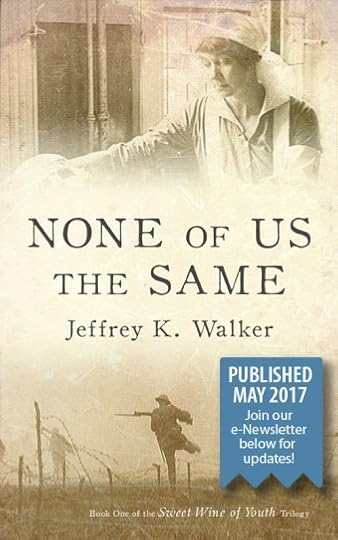
It all began with such enthusiasm, parades and dances and handsome young soldiers in fine new uniforms aching to prove themselves worthy on the field of battle. How did it all go so horribly wrong? When the guns fall silent, can Deirdre overcome her lingering guilt through a new life with Jack, himself battered and trying to forge a place for them at the edge of a wounded Empire now at peace? Can shell-shocked Will bear the weight of his family’s expectations back in Newfoundland?
Their way forward is fraught with guilt, family intrigue, and ill-advised choices yet tinged with blossoming love and acceptance. Can they move past their shared history of suffering and loss in None of Us the Same?
Sweet Wine of Youth: A Historical Trilogy
I’m excited to bring you this first of three books set during and the years after the First World War, an epoch of unprecedented violence and social change. None of Us the Same looks to the consequences of the War on those most profoundly impacted by it. I invite you to join in the exploration of their lives through boldly drawn characters and a vivid historical setting, all created by a writer who knows first-hand what it means to endure mortars and rockets.
Zeppelin Mania
You can always count on CW Hawes for a fascinating account of the airship era. This is not the first time I link to one of his series about airship history and I have a feeling it won’t be the last.
In this series, you will find a detailed breakdown of books about airship and their time, as well as excerpts from a few of those books.
And this a little something more.
The British Dirigible R101
What Really Felled the Hindenburg?

The 4th May was the 80th annyversary of the Hindenburg disaster.
Still today, it isn’t sure what caused it. There are many theories, there are testimonies and even footage of the disaster, but none of this had been enough to reconstruct the events that brought to the biggest airship disaster of all times.
I’ll confess I haven’t had the nerves to watch the videos yet. Just the photos give me the chills.
And so, this is it for this month. I hope you enjoyed the roundup. What is it that you enjoyed the most. I’ll have a wild guess… No, I won’t!
See you next month with more Diesel Era links.
The post Gang Roundup – May 2017 appeared first on The Old Shelter.
May 8, 2017
AtoZ Challenge Reflection Post 2017 – Don’t panic. Plan!
 Well, here we are and, boy, was April a demanding month! I didn’t expect the challenge to be this demanding. My plan was to research in February, write all the posts in March and then dedicate the whole of April to just visit and comment. Nice plan, uh?
Well, here we are and, boy, was April a demanding month! I didn’t expect the challenge to be this demanding. My plan was to research in February, write all the posts in March and then dedicate the whole of April to just visit and comment. Nice plan, uh?
Didn’t exactly worked out.
I did started researching in February… before my laptop crashed. I brought it to the technician and for a few unlucky coincidences, I ended up without laptop for over two weeks. So I read all my material (included an entire ebook) on my phone, which isn’t exactly what I’d recommend as a researching routine. Anyway, at the end of the first week of March, I had all my material done and read and all my notes taken. I was confident that in three weeks I could at least write the first draft of the entire challenge, maybe even start revising.
That’s when the flu struck, and it was horrible. It was quite a serious flu, but I didn’t realise it at first, so stupid me kept working. Didn’t take one day off work, and that had sure been a mistake. I ended up feeling miserable for two weeks, the first of which barely allowed me to drag myself to work and sleep once home.
So if you’ve done your maths, yes, that left me with just one week to write, which means I was always constantly running after, with scant time to read and comment other blogs. So much for my nice plan.
Don’t panic and you’ll learn a lot from the challenge
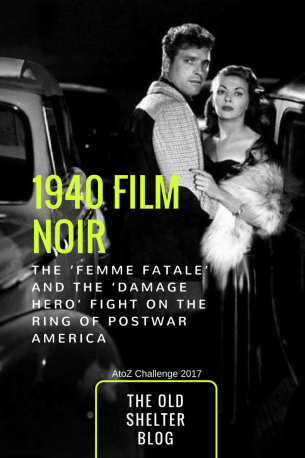 When I started writing my posts I nearly panicked. I wondered, was it a wise choice to pick film noir? I had never studied it before. Well, I did a bit of research for a guest post months ago (that’s why I chose the theme, I enjoyed that post), but I felt completely unprepared. As I wrote the first posts, I felt like a fraud. I had pages and pages of notes and even if I had an idea where I wanted to go with the challenge, I felt overwhelmed.
When I started writing my posts I nearly panicked. I wondered, was it a wise choice to pick film noir? I had never studied it before. Well, I did a bit of research for a guest post months ago (that’s why I chose the theme, I enjoyed that post), but I felt completely unprepared. As I wrote the first posts, I felt like a fraud. I had pages and pages of notes and even if I had an idea where I wanted to go with the challenge, I felt overwhelmed.
But it was too late to rethink, so I had to do my best with the theme I had chosen.
Turned out to be great fun. Yes, I did like researching, but it was when I wrote down my own posts and I started seeing a theory taking form that I really got into the subject and learned from it.
I’m very very happy I stuck with this theme because I enjoyed it a lot. It was very insightful for me, I learned a lot of things I didn’t know, both about film noir, American and German cinema and also about storytelling. I won’t hesitate to say it was inspiring.
And there was what I love the most about the challenge: connecting. This is the very best of it. Meeting new people, discovering new blogs, reading, comment, share. This is the reason why I always try to plan in advance, because it leaves more time to network, to get in touch.
I’ll give this to the challenge, I’ve always learned something from it, especially about blogging. This years it was:
Never despair. There is always time enough if you want to do something, because you’ll make time and make it work. If that means reading researching material on my phone, I’ll do it. If that means revising and building a post ‘till 1am, I’ll do it. If that means sitting down to write even when you really don’t fill like it, because tomorrow you’ll have a crappy first draft which is always better than nothing, I’ll do it… especially if the post is due up the day after tomorrow. Deadlines have always been a great spur for me.
Prioritise. When you’re short on time, you need to decide your priorities and go with those. In the past two years, I went mad trying to keep up with both answering comment on my blog, commenting on other people’s blogs and finalising my posts. Because this year I had very little time, I decided I’d dedicate one day to one thing: one day to write, one day to comment on other blogs, one day to answer comments on my blog. I have to say this worked a lot better than running around trying to do everything. Yes, I fell behind on many occasions, but I finally caught up with everything, which is the thing. Makes me think that I should do something similar to my normal scheduling too.
Plan. Kind of the mantra of the challenge, isn’t it? But it’s definitely a tipping point.
Finalising one post will take more time than you think, remember that. Time will vary from blogger to blogger, but for me just building the post once I had everything ready (the text, the graphics, any links, pics and videos) took me over one hour. And I already knew that, but believe me, when you have 26 posts to schedule, you will underestimate what that means in terms of time.
Here again the best thing is taking the time you need, don’t panic. In many an occasion, I thought the text was ok, then I thought I’d read it once again. Then I thought I’d read it again. Then I though one more time won’t hurt. If you feel you should, just do it, doesn’t matter if it takes some more time. If you feel you should check it out again, it’s because it need checking out. I guarantee you.
Do share. This is something that the challenge taught me the first time I took part: share the hell out of it. Share your posts, share the posts you enjoyed, share what people you follow share, reciprocate people who shared your posts. It takes just a few seconds to share a post you liked… and why you shouldn’t? When I discover something I like, I want everybody to know it. When I started to blog, I thought this was cumbering, I didn’t really know what – or even how – to share, but the challenge taught me you can read and comment and share and still have plenty of time to do other things. Seriously: share it!
Basically, what I learned from this challenge is that quality is king and we should strive to achieve it. The way we do so, the time we take to reach that goal is totally up to us. But if we really want to go there, we’ll find the way, whether that means managing time better, renouncing to something, sleep a lot less than you think you need.
I didn’t regret doing it. Despondent as I had started, I ended up loving my theme.
2017 AtoZ experimentation, how it went for me
This year the challenge was managed in a very different way than the previous years, so let me reflect on this as the organizers asked us for.
 There had always been a linky list that gathered the participant blogs, but as the challenge grew, the list became duped. Many blogs signed up but then didn’t take part, and there was a number of blogs that signed up merely because they knew a lot of people was going to check every single entry in the list.
There had always been a linky list that gathered the participant blogs, but as the challenge grew, the list became duped. Many blogs signed up but then didn’t take part, and there was a number of blogs that signed up merely because they knew a lot of people was going to check every single entry in the list.
Keeping the list clean had become a chore for the organizers (and I understand that), so this year they decided to do it a different way: no linky list, and instead post every day on the official blog where all participants would comment, living a link to their post for the day.
Before the challenge started there was quite some argument about it. Many people thought that having the additional chore to post every day on the official blog would be bothersome and many pointed out that having no official list was going to be wonky.
Personally, I didn’t mind the new method. I had taken part to the challenge only twice before, so I couldn’t say I was ‘accustoned’ to one way of doing it. I was perfectly fine with the new method too.
After trying it, this is what I think:
I’m not sure the posting method is even. Because posting is affected by our time zone, the same people always got to post in the upper part of the comment section, and the same people always ended up in the lower part of the comment section. Last year we had a very long list of blogs to check, but the linky list was still quite manageable on one page, and we could decide to start checking anywhere on the list (it was suggested to start from the blog below us) so that all blogs had a chance to be seen.
The comment section is very different. With nearly 600 comments on the first letter, I wonder how many got to check to the end of the page. This means that our time zone affected our possibility to be seen and read
Because the comment section were always overwhelming, I soon stopped checking. I did look up the entire Theme Reveal comment section, but on the first letter I gave up. Too much to do managing my own blog and visiting other blogs. I felt it took too long to scroll down that comment list.
It also took some trials before I figure out how to open a link in a new tab, so that I didn’t have to scroll down the comment section again. That was a bit awkward.
At the end of the day, I ended up not bothering about the comment section of the official blog other than to post my link… just in case.
Most of my discovering was done through the actual blogs: people who commented on my blog (I always reciprocate), tweets on other blogger’s feed, people commenting on other blogs I liked. Basically, the mere mechanics of blogging and sharing.
In the end, I did kind of miss the linky list, but then, April is always so busy that I’m not sure I’d have done my challenge differently even with the list.
If I should give a suggestion, since I understand the linky list is not going to come back, it would be to maybe give more time and space to the Theme Reveal, so that we’ll have more time to discover blogs before the challenge starts.
I also missed the AtoZChat, which was another way to get in touch with people and blogs before the challenge started.
I’d be curious to see some stats about this year’s challenge. It’s probably just me, but I had the impression less people took part and that there was less diversity of offering. For example, I thought there was an overwhelming number of blogs doing fiction (not that I complain about that!) and less unique themes.
So, this is it for this year, folks. Let’s start planning for next year!
Smashwords | Barnes&Nobles | Kobo | iBookStore
And many other stores
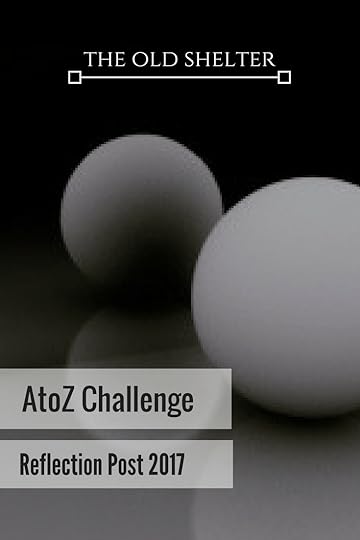
The post AtoZ Challenge Reflection Post 2017 – Don’t panic. Plan! appeared first on The Old Shelter.
May 4, 2017
Thursday Quotables – Ruddy Gore (Miss Fisher Mysteries)
‘Hmm,’ said Dot, taking another chop. ‘That’s a puzzler, Miss.’
‘Then there are the appearances of the ghost. What do you think about ghosts, Dot?’
‘You should get onto the church. You should call Father Ryan. It’s their business,’ said Dot firmly. ‘All this spirit talking and table-turning, it’s mortally sinful.’
‘Now, I suppose, is not the time to tell you that I am going to the Spiritualist church tonight with Selwyn Alexander?’ asked Phryne with a smile.
‘Oh, Miss, you be careful.’
‘I’ll be safe with Selwyn, Dot. He’s in love with Miss Esperance as who wouldn’t be. She is perfectly beautiful.’
‘It’s not your virtue I’m worrying about, Miss, I reckon you can take care of that. But Father Ryan preached about it only last week. Possession, he said, possession is the great danger of spiritualism and he was talking about an exorcism he had performed. Some silly madam was playing with an Ouija board and got herself possessed. He says they aren’t the spirits of the dead, who are with God, but the temptations of the Devil.’
‘Dot dear, I’m sure that the Devil had other things to do.’
‘No, Miss, he’s got plenty of time – he “walks to and fro upon the earth, seeking whom he might devour” – that’s what the Bible says.’ Dot was in deep earnest and Phryne patted her hand.
‘I don’t think you can be possessed unless you want to,’ she soothed. ‘And I don’t want to be. It can’t be that bad, Dot dear, lots of people go to these spirit readings – it’s been popular ever since so many young men didn’t come home from the War. There are many lost souls.’
‘Souls,’ said Dot firmly, ‘are with God.’
‘You know what I mean. If it makes some poor bereaved mother feel better if she thinks that her son is somewhere with a lot of flowers and happy singing – much though that might not have suited him in his earthly form – what harm does it do?’
‘It’s dangerous,’ said Dot mulishly. ‘I don’t like it, Miss.’
‘Then I’m sorry, but I’m going.’
 I’m happy this wasn’t the first Miss Fisher novel I read. Don’t get me wrong, I liked it, but in many ways it was less intriguing than the first I read.
I’m happy this wasn’t the first Miss Fisher novel I read. Don’t get me wrong, I liked it, but in many ways it was less intriguing than the first I read.
The first half of the novel leans heavily on dialogue, there is very little action. It is enjoyable anyway because Greenwood peoples her theatre of many interesting, quirky, unique characters, but there are so many of them and some gets very little time in the story, that I ended up mixing them up. Not all of them, of course, but enough to get confused, especially in the end.
There are three mysteries in this novels, which I like, but again, they tend to become mixed together, which if it’s something I find good (because that’s how life works) it’s also something that I found confusing. I suppose the problem is I had a hard time identifying a main course of the story that would have guided me through it.
I missed the usual cast. This is a story that focuses very much on Phryne. Some of the usual characters show up, but they remain on the fringes, even Jack Robinson, who, after all, is investigating the crime. As I said, there are plenty of other interesting characters, so I’m not complaining, I just missed the usual ‘friends’.
—————————————————
In post is part of the Thursday Quotables meme. If you want to discover more about this meme and maybe take part in it, head over to Bookshelf Fantasies

The post Thursday Quotables – Ruddy Gore (Miss Fisher Mysteries) appeared first on The Old Shelter.
Thursday Quotables – Ruddy Gore
‘Hmm,’ said Dot, taking another chop. ‘That’s a puzzler, Miss.’
‘Then there are the appearances of the ghost. What do you think about ghosts, Dot?’
‘You should get onto the church. You should call Father Ryan. It’s their business,’ said Dot firmly. ‘All this spirit talking and table-turning, it’s mortally sinful.’
‘Now, I suppose, is not the time to tell you that I am going to the Spiritualist church tonight with Selwyn Alexander?’ asked Phryne with a smile.
‘Oh, Miss, you be careful.’
‘I’ll be safe with Selwyn, Dot. He’s in love with Miss Esperance as who wouldn’t be. She is perfectly beautiful.’
‘It’s not your virtue I’m worrying about, Miss, I reckon you can take care of that. But Father Ryan preached about it only last week. Possession, he said, possession is the great danger of spiritualism and he was talking about an exorcism he had performed. Some silly madam was playing with an Ouija board and got herself possessed. He says they aren’t the spirits of the dead, who are with God, but the temptations of the Devil.’
‘Dot dear, I’m sure that the Devil had other things to do.’
‘No, Miss, he’s got plenty of time – he “walks to and fro upon the earth, seeking whom he might devour” – that’s what the Bible says.’ Dot was in deep earnest and Phryne patted her hand.
‘I don’t think you can be possessed unless you want to,’ she soothed. ‘And I don’t want to be. It can’t be that bad, Dot dear, lots of people go to these spirit readings – it’s been popular ever since so many young men didn’t come home from the War. There are many lost souls.’
‘Souls,’ said Dot firmly, ‘are with God.’
‘You know what I mean. If it makes some poor bereaved mother feel better if she thinks that her son is somewhere with a lot of flowers and happy singing – much though that might not have suited him in his earthly form – what harm does it do?’
‘It’s dangerous,’ said Dot mulishly. ‘I don’t like it, Miss.’
‘Then I’m sorry, but I’m going.’
I’m happy this wasn’t the first Miss Fisher novel I read. Don’t get me wrong, I liked it, but in many ways it was less intriguing than the first I read.
The first half of the novel leans heavily on dialogue, there is very little action. It is enjoyable anyway because Greenwood peoples her theatre of many interesting, quirky, unique characters, but there are so many of them and some gets very little time in the story, that I ended up mixing them up. Not all of them, of course, but enough to get confused, especially in the end.
There are three mysteries in this novels, which I like, but again, they tend to become mixed together, which if it’s something I find good (because that’s how life works) it’s also something that I found confusing. I suppose the problem is I had a hard time identifying a main course of the story that would have guided me through it.
I missed the usual cast. This is a story that focuses very much on Phryne. Some of the usual characters show up, but they remain on the fringes, even Jack Robinson, who, after all, is investigating the crime. As I said, there are plenty of other interesting characters, so I’m not complaining, I just missed the usual ‘friends’.
—————————————————
In post is part of the Thursday Quotables meme. If you want to discover more about this meme and maybe take part in it, head over to Bookshelf Fantasies

The post Thursday Quotables – Ruddy Gore appeared first on The Old Shelter.
April 29, 2017
Zeitgeist (1940s Film Noir – #AtoZChallenge)
 Film noir is a form of psychological thriller that emerged in the time of the war and were directed by a new generation of European expatriates newly arrived in Hollywood.
Film noir is a form of psychological thriller that emerged in the time of the war and were directed by a new generation of European expatriates newly arrived in Hollywood.
It expressed the feeling of people trapped in the webs of paranoia and fear, unable to tell guilt from innocence, true identity from false. Mirroring the insecurities of postwar America, in the end evil is exposed, though often just barely and the survival of good remains troubled and ambiguous.
Film noir is so strongly bound to the 1940s in so many ways that we could trace the arc of the change in America society by looking at the evolution of these films.
Wartime period (1941-1946) is the fase of the private eye and the lone wolf, and in general there is more talk than action. This is when war started to impress its fear and insecurities upon American people, who felt alone and unprotected in the face of a huge disaster. Hollywood started to find new ways of expressing this in films.
Postwar realism (1945-1949) Films focused more on the problem of crime in the street and political corruption. Less romantic heroes make their appearance. These heroes face insecurity and displacement in a world that they can’t call their own anymore and they seem to havevery little tools to navigate it (let alone control it).
Psychotic action and suicidal impulse (1949-1953) The psychotic killer (who barely existed in the first period and who was just at the fringes of the story in the second period) takes central stage. Anxiety turns into paranoia as the Cold War becomes a pervasive presence in the lifes of so many people.
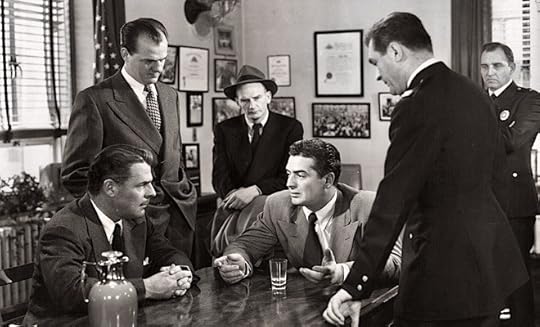
Kiss of Death
Far from being bound to the 1940s, #FilmNoir reaches to us through the decades
Click To Tweet
So, can it be said that film noir depicts the zeitgeist of the 1940s?
Critics don’t seem to agree. In spite of all the many connections between film noir and the time period it was produced in, there is still something more to this films, something that goes beyond the limits of time and that in later decades would have produce the neo noir.
By depicting the 1940s with characteristic that were closely bound to that time, film noir produced something universal, something that is still able to speak to viewers decades later.
——————————————————————————-
FILMS CITED
Kiss of Death (1947) by Henry Hathaway
Offered parole from Sing Sing in exchange for information about one of his old partners in crime, jewel thief Nick Bianco (Victor Mature) reluctantly cooperates with district attorney Louis D’Angelo (Brian Donlevy), who’s trying to take down violent murderer Tommy Udo (Richard Widmark). But when Udo goes free despite the district attorney’s best efforts, Bianco and his wife, Nettie (Coleen Gray), are in the killer’s sights, and he’ll stop at nothing to settle the score. (Google synopsis)
——————————————————————————-
READ MORE ABOUT IT
Schrader, Paul. Note on Film Noir. Filmex (First Los Angeles International Film Exposition), Los Angeles, 1971
Vanity Fair – Day Into Noir
Smashwords | Barnes&Nobles | Kobo | iBookStore
And many other stores
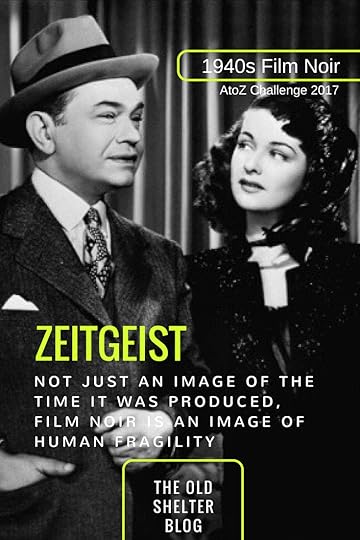
The post Zeitgeist (1940s Film Noir – #AtoZChallenge) appeared first on The Old Shelter.
April 28, 2017
Years 1940s (1940s Film Noir – #AtoZChallenge)
 Classic film noir is a form of entertainment characteristic of the 1940s. That’s when its popularity reached a peak, for many different reasons and also for social, cultural and economic situations that pertain to that specific time.
Classic film noir is a form of entertainment characteristic of the 1940s. That’s when its popularity reached a peak, for many different reasons and also for social, cultural and economic situations that pertain to that specific time.
The hard boiled novels had been popular for some twenty years before Hollywood took it up and transformed it into the tough thriller film. Because of their popularity, there had been attempts to turn hard boiled novel into film in the 1930s, but the treatment they received in order to make them viable for both Hollywood industry and its audience had transformed the original stories so profoundly that those early attempts at hard boiled films could hardly be considered hard boiled at all. The Maltese Falcon was made into film twice (once in 1931 and once in 1936) before its more faithful adaptation of 1941, the first that proved to be successful. By that time, Hollywood had started turning to war anxiety and a way to depict it on screen.
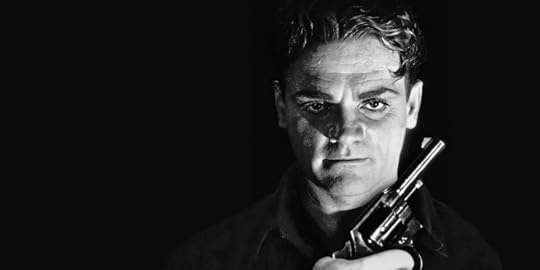
White Heat
War brought a series of difficulties that helped to popularise film noir. First of all , a shortage of everything. Stars were drafted and left Hollywood with the ‘problem’ to cope with less known actors. Funds shrunk because money went to the war effort and cinematographers had to find new way to produce films with a lower budget.
At the same time, war also produced a shortage of paper, which led to less novels and newspapers be printed. This meant less hard boiled novels were available and Hollywood replaced them with similar films. Besides, novels as source (a story created by a professional, specialised writer) was one of the alternative values B movies like film noir were able to offer with no additional cost.
By the time #cinema critics noticed #FilmNoir in the 1950s, it was already fading
Click To Tweet
From 1944 to 1948 film noir was one of the most popular form of films and this is indeed its golden age. In most accounts, film noir is explicitly or implicitly regarded as a reflection of the various social and cultural upheavals experienced by the US in the 1940s. But as America entered the 1950s, the interest of the public once again shifted, postwar problems were elaborated and a new society came along.
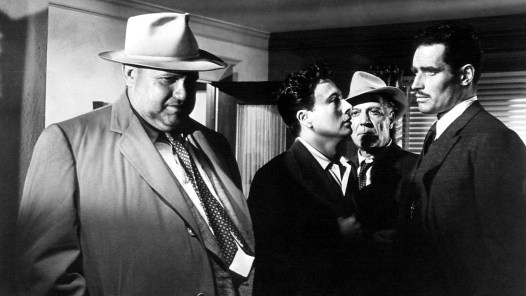
Touch of Evil
By the mid-1950s noir had grounded to a halt. There were still a few notable struggles, with Touch of Evil (1958) considered by many the very last classic film noir produced (though many critics consider the film noir season ended by the early 1950s).
A new stile of crime fiction had become popular, a more ‘bourgeois’ kind of thriller where criminals were smooth and elegant and the lone hero was replaced by the professionalism of the ‘mobile unit’. There’s no place for grime and twisted personality in these new films, the audience now wanted something safer.
The way the audience consumed films changed too. In the 1950s, television became more and more common, to the point that most American families had a set in their house. Film production started to adapt to that new form, serials were produced especially for television and a new form of lighting that was the exact contrary of chiaroscuro became popular and familiar.
The kind of distribution that had allowed so many B movies to be produced and sold came to an end too. Studios could no longer force movie theatres to buy bundles of B movie in order to have one A movie, so the production of B movie sank.
In the moment critics started to discover film noir, film noir itself faded away. It would be nearly twenty years before it would rise again.
——————————————————————————-
FILMS CITED
White Heat (1949) by Raoul Walsh
Gang leader Cody Jarrett (James Cagney) lives for his mother, planning heists between horrible headaches. During a train robbery that goes wrong, Cody shoots an investigator. Realizing Cody will never be stopped if he knows he’s being pursued, authorities plant undercover agent Hank (Edmond O’Brien) in Cody’s cell. When his mother dies, a distraught Cody breaks out of jail, bringing Hank along to join his gang. With Hank in communication with the police, Cody plans a payroll heist. (Google synopsis)
Touch of Evil (1958) by Orson Welles
When a car bomb explodes on the American side of the U.S./Mexico border, Mexican drug enforcement agent Miguel Vargas (Charlton Heston) begins his investigation, along with American police captain Hank Quinlan (Orson Welles). When Vargas begins to suspect that Quinlan and his shady partner, Menzies (Joseph Calleia), are planting evidence to frame an innocent man, his investigations into their possible corruption quickly put himself and his new bride, Susie (Janet Leigh), in jeopardy. (Google synopsis)
——————————————————————————-
READ MORE ABOUT IT
Krutnik, Frank, In a Lonely Street. Routledge, 1991, London/NYC
Schrader, Paul. Note on Film Noir. Filmex (First Los Angeles International Film Exposition), Los Angeles, 1971
Smashwords | Barnes&Nobles | Kobo | iBookStore
And many other stores
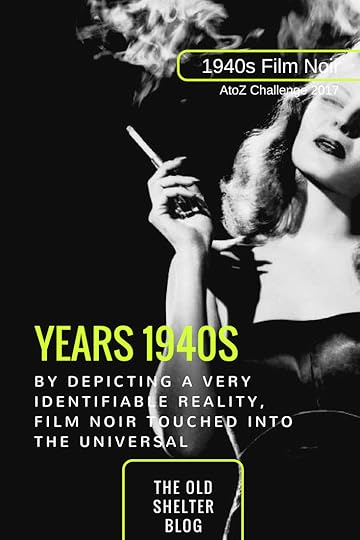
The post Years 1940s (1940s Film Noir – #AtoZChallenge) appeared first on The Old Shelter.
April 27, 2017
Xenos (1940s Film Noir – #AtoZChallenge)
 The though thriller is a particularly heightened form of hero-centred fiction, but with a non-traditional outcome engendered by the problematisation of the hero figure.
The though thriller is a particularly heightened form of hero-centred fiction, but with a non-traditional outcome engendered by the problematisation of the hero figure.
In place of the conventional affirmation of heroic masculinity, the 1940s thrillers offer a range of alternative or ‘transgressive’ representations of male destiny and identity, which questions the network of male cultural authority. The noir hero does act as the controlled, unified traditional hero, but many elements in the film suggest that appearance is just… well, appearance.
The relation with the femme fatale becomes particularly tricky, since she’s often the mover of the story, but she’s a distant ‘other’, outside of the story’s perspective and motives. The male perspective is structured as the norm and the touchstone of authority, the feminine is seen as a disturbant, sometimes deadly alternative.
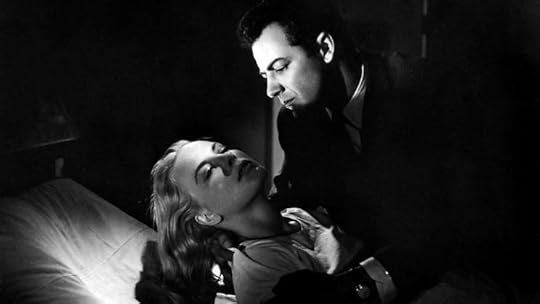
The Big Combo
Here resides the most interesting part of the fascination we still have with film noir.
By all accounts, film noir should be an old form of narration that doesn’t have anything to do with us today. Structure around the problematic relation between men and women that was characteristic of a very specific time (the 1940s), it seem to have little in common with man/women relationships today. Film noir centred on a very specific experience bound to a very specific time (post WWII era), addressing, if in a filtered way, problematics that belonged to that specific time (the maladjustment of returning veterans, the resentment of women forcefully expelled from the workforce, the confusion of wartime sexual roles).
But we still enjoy film noir, it still makes sense to us. Born nearly by chance, it has become a language we know and use.
Why is that?
The distant and unknowable 'other', the true source of #FilmNoir anxiety
Click To Tweet
The power of storytelling, when it is meaningful, is that it never speaks of the here and now, but rather of the everywhere and always.
In good storytelling, we have characters that look like real people because they act like real people. They face situations that are familiar to the reader/viewer because those situation resonates with the audince’s everyday experience, and thus it feels real. The kind of storytelling film noir enacts is grounded in the moment these films were produced, they speak of the people the viewers could encounter everyday in they real life and the experience were likewise expereincing (the war, the agressively ‘mprenditorial’ women, the difficult return to normalcy) Viewers lived and heard about in their everyday life.
But if film noir had only addressed these realities, it would be old and done by now. Thing is, film noir is good storytelling.
In good storytelling, characters not only look, feel, speak and act like real people, they are also symbols. And the plot not only rings of true experience, but it also illustrates ideas. This is how good storytelling breaks away from the story contingencies and become universal. In good storytelling, the plot and the characters are grounded in reality (often the author’s reality) but speaks of emotions that reside deep in everyone of us. The actual story and charactes are just figurations of more abstranc ideas.
And because these ideas and emotions belong to all of us regadless of the time and place we live, we can reach into that deeper meaning beyond the contingency of the story and grasp at the universal message underneath.
This is why good storytelling is forever.
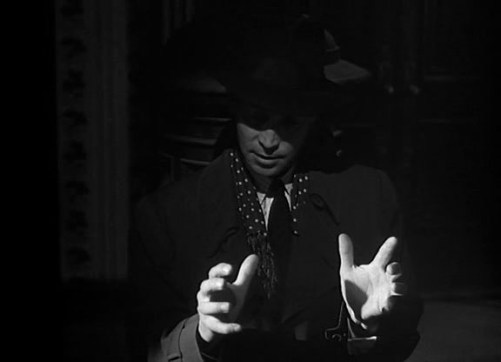
Phantom Lady
I believe that by depicting a very specific reality, but in a stylised way, film noir went beyond its limits of time and circumstances. Just like the cinematographers who broke the many limits imposed on them, film noir broke the apparent limits of its contingency and went into a universal space.
Male authority is considered the norm in film noir, and the female action is considered the disturbance. But if we consider that the norm is ‘us’ and the disturbance is the ‘other’, and that the clashing of these forces produces an anxiety that comes from the uncertainty of the outcome, then we can read (and speak) film noir in very different ways.
The confrontation between the hero and the femme fatal can then be seen as a narrational tool to express a very deep anxiety concerning change and the way we as humans cope with it. It speaks of new encounters we don’t know how to handle (the unscrutable ‘other’, the femme fatal), of shifting situations we don’t know how to cope with (the shifting roles of men and women in 1940s American society), of the sense of powerlessness we expereince while the change is happening (the hero’s lack of control on the story). But because these figurations stand in place of a more universal meaning, they can be rearrenged by viewers so to become meaningful to them.
In today’s society for exapmple the unscrutable ‘other’ may be someone belonging to a different culture. The shifting roles may apply to influx of different people into an established society. The lack of control may refer to the axiety and fear this forced clash of cultures engenders.
Fear of change was at the very core of film noir, and that’s a universal feeling. In the 1940s, that reflected the new role of women and its social meaning and the difficulties returning veterans had to readjust to peacetime society. In our times, that may reflect the change of a society that is mixing at a very fast pace and pushes together cultures that are unprepared to effectively deal with each other.
The confrontation between the opposites that never meet and never fully understand each other that film noir enacts is very much close to our experience today.
That’s why film noir is forever.
——————————————————————————-
FILMS CITED
The Big Combo (1955) by Joseph H. Lewis
Police Lt. Diamond is told to close his surveillance of suspected mob boss Mr. Brown because it’s costing the department too much money with no results. Diamond makes one last attempt to uncover evidence against Brown by going to Brown’s girlfriend, Susan Lowell. (MUBI synopsis)
Phantom Lady (1946) by Robert Siodmak
Scott Henderson’s (Alan Curtis) innocuous evening with a strange woman becomes crucial when he is later accused of murdering his wife on the same evening. When Scott’s story is disbelieved and a trial fails to bring forth the “phantom lady,” Scott’s devoted girl Friday, secretary Carol Richman (Ella Raines), begins her own investigation with the aid of police inspector Burgess (Thomas Gomez). A high point is Carol’s unexpected kinky moment with an obsessed jazz drummer (Elisha Cook Jr.). (Google synopsis)
——————————————————————————-
READ MORE ABOUT IT
Krutnik, Frank, In a Lonely Street. Routledge, 1991, London/NYC
Smashwords | Barnes&Nobles | Kobo | iBookStore
And many other stores
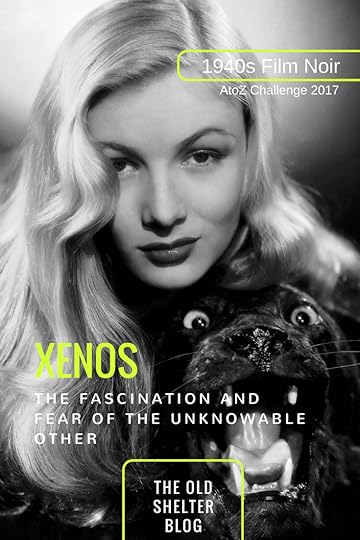
The post Xenos (1940s Film Noir – #AtoZChallenge) appeared first on The Old Shelter.
April 26, 2017
World War II (1940s Film Noir – #AtoZChallenge)
 World War II produced a fracture in American society. While men created their own social order at the front, women revolutionised their role at home.
World War II produced a fracture in American society. While men created their own social order at the front, women revolutionised their role at home.
The war put soldiers in an environment that forced them to redefine the characteristics that were useful in a man: courage and bravery, physical prowess, strategic thinking and, not least, the ability to successfully use violence to achieve a particular goal.
The men who survived the war and went back home had become very skilful in these fields, but once home, they discovered what were chief skills in the fight of survival at the front, were utterly useless, when not even considered dangerous and undesirable in a peaceful society.
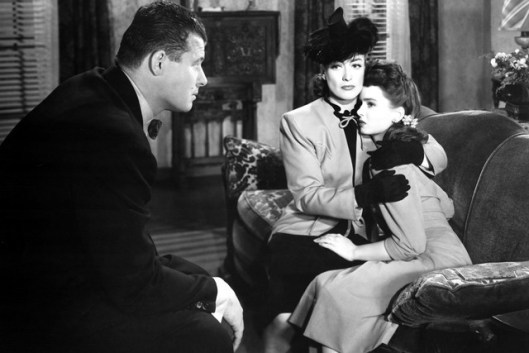
Mildred Pierce
At the same time, the war effort had pushed many women out of the house and into the workforce. Since men were at the front, women were not only allowed, but outright encouraged to replace men in positions that had never before been available to them. The ardent response of the American women to the war effort to some degree reflected a pervasive frustration with their traditional genre assignments. When given the possibility, women searched for even limited amount of autonomy and self reliance. Their place in American society was transformed forever.
All through the war years, the social role of men and women evolved in very different directions, and when veterans went home and those two worlds found themselves together once more, they didn’t match anymore.
This created uncertainty, anxiety and a very strong sense of confusion, on the part of both men and women. The arts and entertainment caught on this feelings (because this was what people cared about) and transformed them into new forms of entertainment.
#WWII created a divide that looked insurmountable between men and women #FilmNoir
Click To Tweet
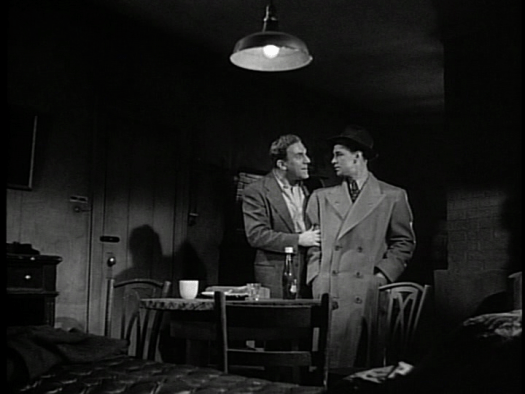
The Glass Key
Film noir was one of these new forms, one that spontaneously arose from the cultural and social environment.
In film noir, men tried to use the skills they learned at the front (tried to be cool and professional) but found themselves in very uncomfortable positions in the world they lived, often unable to effectively handle the situation, sometimes caught in plots they had no control over.
Because film noir mostly took up the male perspective, women were often portrayed in a disparaging way. They became duplicitous vixen, sexually powerful and poisonous to the men. And this is of course a transfiguration of the anxiety the shifting role of women were projecting on a changing society.
Although in a completely transformed look, film noir truly speaks of the anxiety of a generation, of the confusion and the uncertainty to which it could offer very little solutions.
——————————————————————————-
FILMS CITED
Mildred Pierce (1945) by Michael Curtiz
When Mildred Pierce’s (Joan Crawford) wealthy husband leaves her for another woman, Mildred decides to raise her two daughters on her own. Despite Mildred’s financial successes in the restaurant business, her oldest daughter, Veda (Ann Blyth), resents her mother for degrading their social status. In the midst of a police investigation after the death of her second husband (Zachary Scott), Mildred must evaluate her own freedom and her complicated relationship with her daughter. (Google synopsis)
The Glass Key (1947) by Stuart Heisler
Political boss Paul Madvig (Brian Donlevy) falls for reform politician Ralph Henry’s attractive daughter Janet (Veronica Lake), despite the caution of his best friend, Ed Beaumont (Alan Ladd). Paul’s efforts to disassociate himself from the criminal underworld backfire, however, when he is accused of murdering Janet’s disreputable brother, and a casino owner Paul had offended sends his sadistic thugs after Ed in revenge. (Google synopsis)
——————————————————————————-
READ MORE ABOUT IT
Krutnik, Frank, In a Lonely Street. Routledge, 1991, London/NYC
Scott Snyder, Personality Disorder and the Film Noir Femme Fatale, University of Georgia, 2001
Smashwords | Barnes&Nobles | Kobo | iBookStore
And many other stores
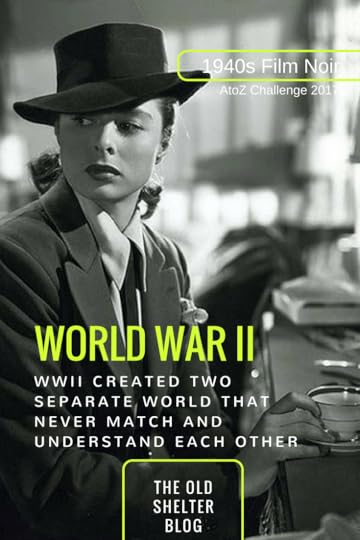
The post World War II (1940s Film Noir – #AtoZChallenge) appeared first on The Old Shelter.
April 25, 2017
Veterans (1940s Film Noir – #AtoZChallenge)
 Many movies of the 1940s dealt with the figure of the returning veteran, as it is expected, because that was an important aspect of 1940s American life.
Many movies of the 1940s dealt with the figure of the returning veteran, as it is expected, because that was an important aspect of 1940s American life.
These soldiers had been away sometimes for years, into an environment that was completely different from peacetime life. They had been separated from women, thrown in a context of extreme violence, where death was a very likely possibility and put in constant proximity with other men, with a degree of mutual dependence that was unmatched in civilian life.
Once home, they were still more comfortable in the company of other men and found it hard to cope with a lifestyle that didn’t allow violence as a problem-solving tool.
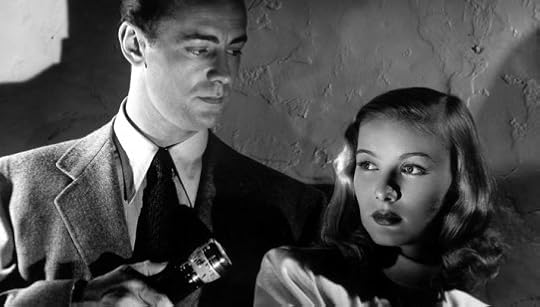
The Blue Dahlia
In The Blue Dahlia, Johnny comes home to find his wife had been unfaithful and is now particularly scornful of him. Johnny reacts to this with violence, which later points at him when hid wife is found death. Just in the premice, it is possible to see several of the returning veteran’s axiety: betrayal from thier wives, displacemet from life has has gon on at home, inability to handle difficult situation without recurring to violence. In one of Johnny’s friend, then, the film even touches on the problem of shock-shell, which many veterance suffered once at home and which in many ways amplified every veteran’s problem.
Veteran films betrayed a marked hostility toward (and by implication a fear of) postwar integration.
The returning veterans films (and many film noirs fall into this category) addressed this awkwardness, this uneasiness, even this disillusionment not by mirroring what happened in true life, but by engaging a series of complex transformations that pertain to the realm of storytelling. The damaged hero, the femme fatale, the criminal plan aren’t faithful depiction of life as it was, but these symbols allow that reality to filter into the narrative structure. Film noir transformed social realities in mood and feelings, then codified them in terms of conventional narratives, subjecting them to logics and resolutions familiar to the viewers.
The returning veteran and his maladjustment was a recurring theme in #FilmNoir
Click To Tweet

Dark Passage
By transforming a chaotic reality into a regulated story structure, storytelling allows to sublimate and possibly decode that reality. To an extend, storytelling is a way to break the tension by giving tools to handle it.
What is significant about the returning veteran films of the mid-to-late 1940s isn’t the mere presence of such figure, but the fact that it received a standardised addressing within the generic mode of the thriller. These films deliberately drew upon the problem of postwar maladjustment because it was affecting the audience’s everyday life, and in a way storytelling tried to offer relief.
——————————————————————————-
FILMS CITED
The Blue Dahlia (1946) by George Marshall
Discharged naval officer Johnny Morrison (Alan Ladd) returns to his wife, Helen (Doris Dowling), in Hollywood after fighting in the South Pacific, and with him are two military friends, George (Hugh Beaumont) and shell-shocked Buzz (William Bendix). Johnny is stunned to discover Helen’s unfaithfulness with a local nightclub owner named Eddie (Howard Da Silva), who then breaks it off with her. When Helen is found murdered, everyone seems to have a motive. (Google synopsis)
Dark Passage (1947) by Delmer Daves
Stark, claustrophobic thriller about an anti-Semitic soldier who kills a Jewish war veteran, evading detection because of his loyal friends’ protection. However, a detective is determined that the crime will not go unsolved and sets about laying a trap for the murderer. (Google synopsis)
——————————————————————————-
READ MORE ABOUT IT
Krutnik, Frank, In a Lonely Street. Routledge, 1991, London/NYC
Transatlantic Habit – The Returning Veteran in film Noir
Albeit – “War Scarred” Anti-Heroes in Film Noir
Featured image by AlexTeuscher
Smashwords | Barnes&Nobles | Kobo | iBookStore
And many other stores
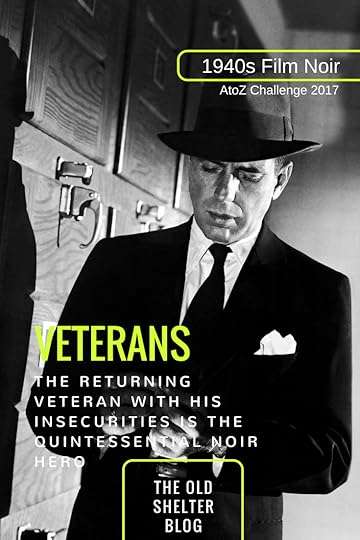
The post Veterans (1940s Film Noir – #AtoZChallenge) appeared first on The Old Shelter.






